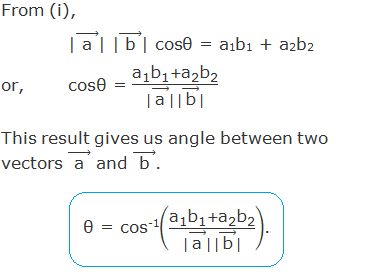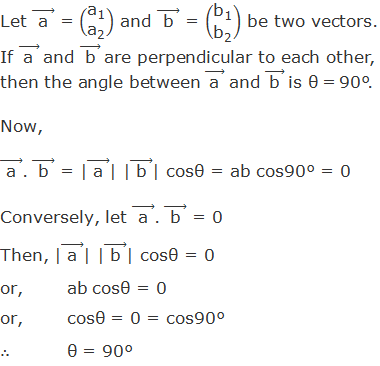
Product of Vectors: Product
of vectors or multiplication of vectors can be
performed in the following two ways:
- Scalar
Product or Dot Product
- Vector Product or Cross Product
********************
10 Math Problems officially announces the release of Quick Math Solver and 10 Math Problems, Apps on Google Play Store for students around the world.
********************
********************
Scalar Product or Dot Product

Scalar Product in Component Form

The angle between two vectors

Properties of the scalar product

Perpendicular vectors

Parallel Vectors

Mutually Perpendicular Unit Vectors

Scalar Product in Terms of Unit Vectors
![Scalar Product in Terms of Unit Vectors Let (" a " ) ⃗ = a1(" i " ) ⃗ + a2(" j " ) ⃗ and (" b " ) ⃗ = b1(" i " ) ⃗ + b2(" j " ) ⃗ be two vectors, then (" a " ) ⃗.(" b " ) ⃗ = (a1(" i " ) ⃗ + a2(" j " ) ⃗).( b1(" i " ) ⃗ + b2(" j " ) ⃗) = a1b1 (" i " ) ⃗.(" i " ) ⃗ + a1b2 (" i " ) ⃗.(" j " ) ⃗ + a2b1 (" j " ) ⃗.(" i " ) ⃗ + a2b2 (" j " ) ⃗.(" j " ) ⃗ = a1b1 + 0 + 0 + a2b2 [∵(" i " ) ⃗.(" j " ) ⃗ = (" j " ) ⃗.(" i " ) ⃗ = 0] = a1b1 + a2b2](https://blogger.googleusercontent.com/img/b/R29vZ2xl/AVvXsEjn3DUww82xIka5nergjLdq8umUere3t0scN7pg536tFhqtEvG2BkyyBQAQARtu9TH2o-4gcJskgB1cNYUXbeNBmHIB0atAT05pAZTGlD2MKYU1QZv0X9DeWoBdMji5YXJzNzgAXFCs4sF7/s16000/Scalar+product+in+terms+of+unit+vectors.png)
Worked Out Examples:








![Example 9: Example 9: In the given figure, ABC is a triangle in which ∠ABC = 120° and AB = AC. Show that AB = "1" /√("3" ) AC. Solution: We have, ("AB" ) ⃗ + ("BC" ) ⃗ = ("AC" ) ⃗ [By triangle law] or, (("AB" ) ⃗ + ("BC" ) ⃗)2 = (("AC" ) ⃗)2 [Squaring] or, (("AB" ) ⃗)2 + 2("AB" ) ⃗ . ("BC" ) ⃗ + (("BC" ) ⃗)2 = (("AC" ) ⃗)2 or, AB2 + 2|("AB" ) ⃗|.|("BC" ) ⃗| cos60° + BC2 = AC2 [█("∵ Angle made by " ("AB" ) ⃗" and " ("BC" ) ⃗" is 180° – 120° " @"= 60° and AB = BC" @)] or, AB2 + 2AB.AB × "1" /"2" + AB2 = AC2 or, 2AB2 + 2 AB2 × "1" /"2" = AC2 or, 3AB2 = AC2 or, AB2 = "1" /"3" AC2 or, AB = "1" /√("3" ) AC Proved.](https://blogger.googleusercontent.com/img/b/R29vZ2xl/AVvXsEj0sDA_0cKa1VTRnvzT6iEfSXj3ejkBawtiLy7dkhuJYzn1PrAm5XN8XuLYCicqee9LBlLiLUOzjQWL8g2yyuHkmVNjHV8w_yLQiF3FMtTluKfjtFFB3uFd2wamruYRP7dmKAg6WNNpKATN/s16000/example+9.png)
![Example 10: Example 10: If ABC be a right angled triangle with ∠BAC = 90°, show by vector method that AB2 + AC2 = BC2. Solution: By triangle law of vector addition, ("BA" ) ⃗ + ("AC" ) ⃗ = ("BC" ) ⃗ i.e. (("BA" ) ⃗ + ("AC" ) ⃗)2 = (("BC" ) ⃗)2 [Squaring] or, (("BA" ) ⃗)2 + 2 ("BA" ) ⃗ . ("AC" ) ⃗ + (("AC" ) ⃗)2 = (("BC" ) ⃗)2 [Since ("BA" ) ⃗ ⊥ ("AC" ) ⃗, ("BA" ) ⃗ . ("AC" ) ⃗ = 0] or, BA2 + 0 + AC2 = BC2 [∵ BA2 = AB2] or, AB2 + AC2 = BC2 Proved.](https://blogger.googleusercontent.com/img/b/R29vZ2xl/AVvXsEiNAv-2FosOwt7Drt4ZBnOU0r0mCSRvyOEZD2gOKhtVJI8FRHxXLp2XHaBK4t7zVi0rl2SMibJmLZDevGkQvAp5XXstq8I67leR9PqhYHm6diDId5oa5jpfNS94mUpNqM0_icdIfqNLYrU4/s16000/example+10.png)
Do you have any questions regarding the product of vectors?
You can ask your questions or problems here, in the comment section below.



0 comments: